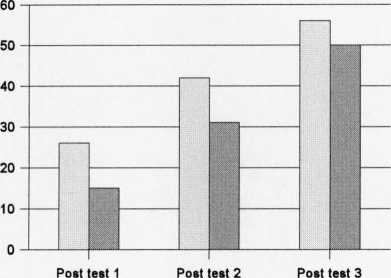Is the provision of semantic justifications influenced by the semantic domain of the lexical
items?
Figure 7.24 shows that the children provided more “semantic” justifications for the words
describing artifacts than for the words describing animals. Significant differences were only
found for post test 1 (Wilcoxon: Z=1.9, p<.05).
Figure 7.24 Provision of semantic justifications by the semantic domain of the lexical
items across testing

J Artifacts I ] Animals
The same analysis was repeated separately for each group. The same pattern was found for
the Definition group during post test 1 (Wilcoxon: Z=2.6, p<.05) and post test 2 (Wilcoxon:
Z=2.04, p<.05). No significant differences were found for post test 3.
Analysis of the Thematic justifications
Is there a differential impact of the type of exposure to new lexical items that the children
receive on the provision of thematic justifications?
Figure 7.25 below shows that during post tests 1 and 2 the Lexical contrast group provided
more “thematic” justifications than the other groups. In addition, during post test 3 the
Phonological control and Control groups provided more “thematic” justifications than the
other groups.
245
More intriguing information
1. Credit Markets and the Propagation of Monetary Policy Shocks2. The name is absent
3. The purpose of this paper is to report on the 2008 inaugural Equal Opportunities Conference held at the University of East Anglia, Norwich
4. Philosophical Perspectives on Trustworthiness and Open-mindedness as Professional Virtues for the Practice of Nursing: Implications for he Moral Education of Nurses
5. The name is absent
6. The name is absent
7. The name is absent
8. The name is absent
9. Voluntary Teaming and Effort
10. Innovation Policy and the Economy, Volume 11